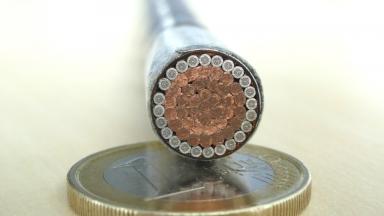Superconductivity
25.08.2016
In the coming decades, the development of renewable energy sources (RES) such as wind and solar will play a major role in reducing our reliance on fossil fuels and making our energy system more sustainable. But the places where RES are available or would be most efficient are often located far away from the densely populated and industrial areas where the energy is needed: on the open sea in the case of offshore wind and in sunnier climes in the case of solar. This means that the construction of new power lines needs to go hand in hand with RES development. In Germany for instance, expanding the electrical grid has become a crucial precondition for the success of the Energiewende. Yet the current technological options for electricity transmission have a number of drawbacks that make them ill-suited to long-distance transmission. What could be a better technology for the energy grid of the future? Scientists at the Research Institute for Sustainability (RIFS) and its partner organisations are developing and advocating an alternative technology: superconducting electric cables, which could provide benefits in terms of size, costs, efficiency and environmental impact.

Superconductivity is the phenomenon that happens when some electrical conductors are cooled down to very low temperatures, triggering the transmission of electricity without any resistive losses. This is a significant advantage: in the case of conventional technologies, power losses range from 2 to 5 per cent for a typical High-Voltage Direct-Current (HVDC) overhead line, and can be as high as 10 per cent for HVDC underground cables. ‘Lossless’ electricity transmission would translate into increased profitability and less wasted energy.
Electricity transport at -253oC
Since its discovery more than a century ago, superconductivity has found many applications, from particle accelerators to medical imaging equipment. In the last two decades, new findings have opened the way to developing superconductivity for electricity transport, as materials have been found with higher ‘critical temperatures’, thus making it easier and cheaper to reach the state of zero resistance. From these, RIFS has selected the superconducting material ‘magnesium-diboride’ (or MgB2), a recently discovered compound that can be readily produced at commercial level using widely available raw materials. It is also cheaper and more flexible than any other competing superconductor. Compared to the expensive, ceramics-based ‘High Temperature Superconductors’ with operating temperatures of 50–70 kelvin (K) (around -200oC), MgB2 has a lower critical temperature. Yet it can be easily manufactured into wires, an essential requirement for power lines.
The RIFS cable design, which is based on an original idea by Nobel Laureate and former Scientific Director Carlo Rubbia, would consist of a Direct-Current (DC) cable setup supplied with a closed loop cryogenic system using either hydrogen or helium to maintain the operating temperature of ~20 K or -253oC. The cable is intended for lengths of hundreds or thousands of kilometres, and would achieve capacities of up to 10 Gigawatts (GW), or possibly even more. By way of comparison, a typical nuclear power plant has a generating capacity of 1–2 GW.
Small cables, large amounts of power
Because of the cryogenic insulation, superconducting cables are best installed underground. This means that superconducting lines would provide the same benefits as standard HVDC underground cables do vis-à-vis overhead lines: above all, a smaller ecological footprint and minimised visual impact. Furthermore, underground cables are not vulnerable to storm damage, they do not emit noise and require less land use.
But the distinct advantage of superconducting lines is their size: because they do not generate significant heat, large amounts of power can be transferred using single, small cables. We expect that the whole installation for a 4 GW, 800-km-long MgB2 cable would have a total diameter of 30 cm, which is much smaller than a conventional HVDC cable with a similar capacity, and vastly smaller than the corridor width needed for an overhead line. This could prove to be a decisive factor with respect to public acceptance. In Germany for instance, the planned SuedLink power line has sparked popular protests motivated in particular by concerns over electromagnetic fields, dropping property values and the visual impact of massive electricity pylons.
A cost-effective option
Finally, the first estimates conducted by RIFS – which are based on extrapolations from our prototype cable, material costs, etc. – show that MgB2 cables would be several times cheaper than standard HVDC cables, and could possibly compete with HVDC overhead lines.
This research project is carried out in cooperation with the European Organization for Nuclear Research (CERN) in Geneva, where laboratory experiments have been carried out over the last two years on progressively longer and more powerful wires. In February 2014, a significant breakthrough occurred when a 20m-long, 16-cm wide prototype cable carried a current of 20 000 amperes, a world record for a superconductor. This success is an important step in the R&D process, setting the course for larger scale experiments. To this end, RIFS has been establishing a network with relevant stakeholders all across Europe: research institutions, cable manufacturers, government agencies, and transmission operators. This has enabled the scientists to gain a better understanding of how MgB2 superconducting lines could fit into the energy grid of the future, and what concrete economic, technical and social conditions are required for their large-scale implementation. Together with these partners, RIFS is also part of a European 7th Framework Programme project in which a demonstrator superconducting cable will be built and tested in operational conditions.
Photos: © CERN


